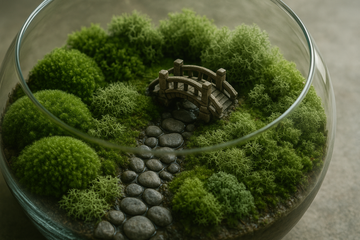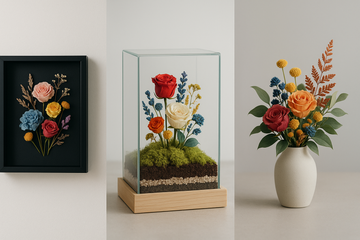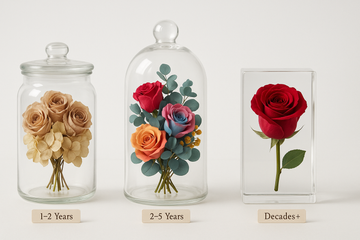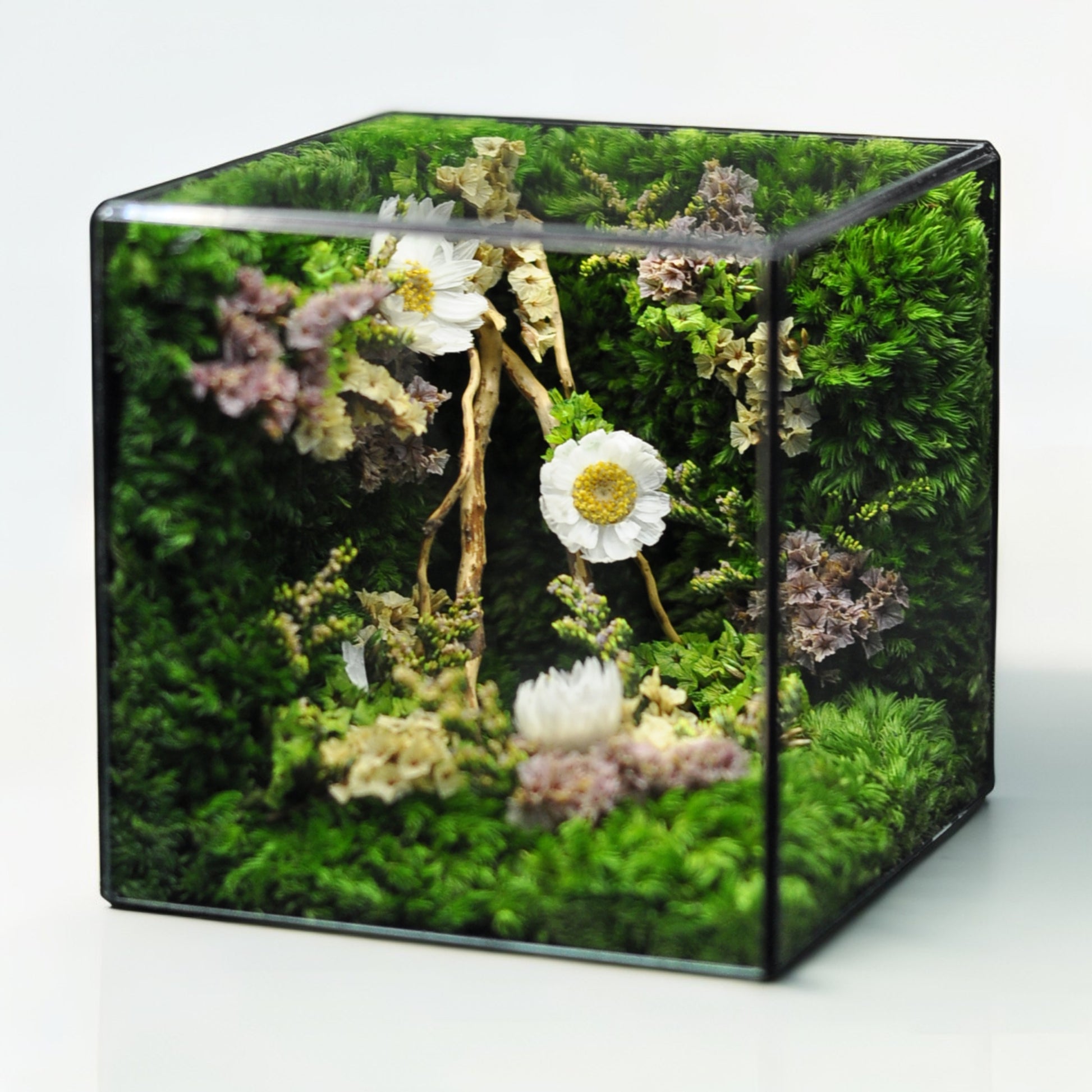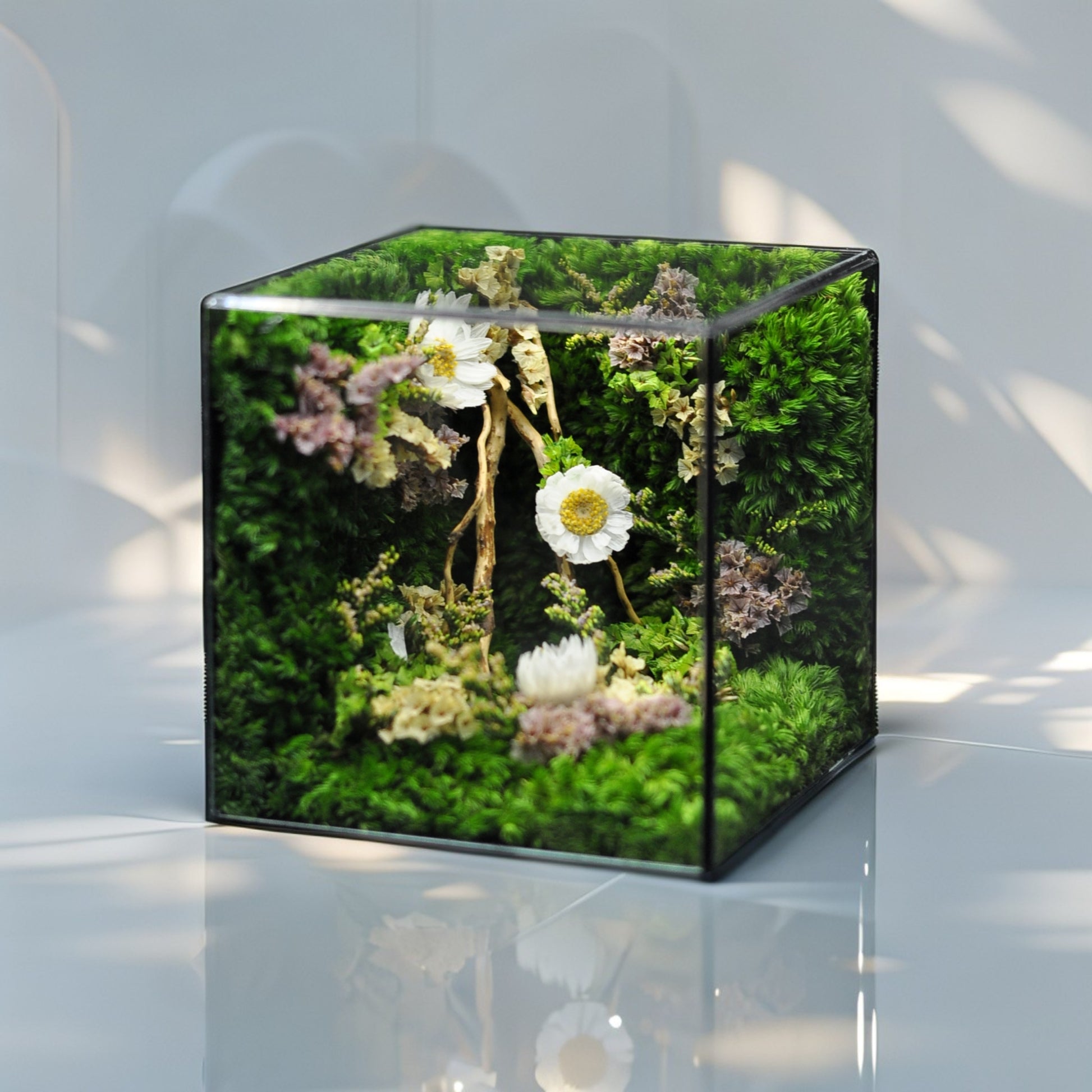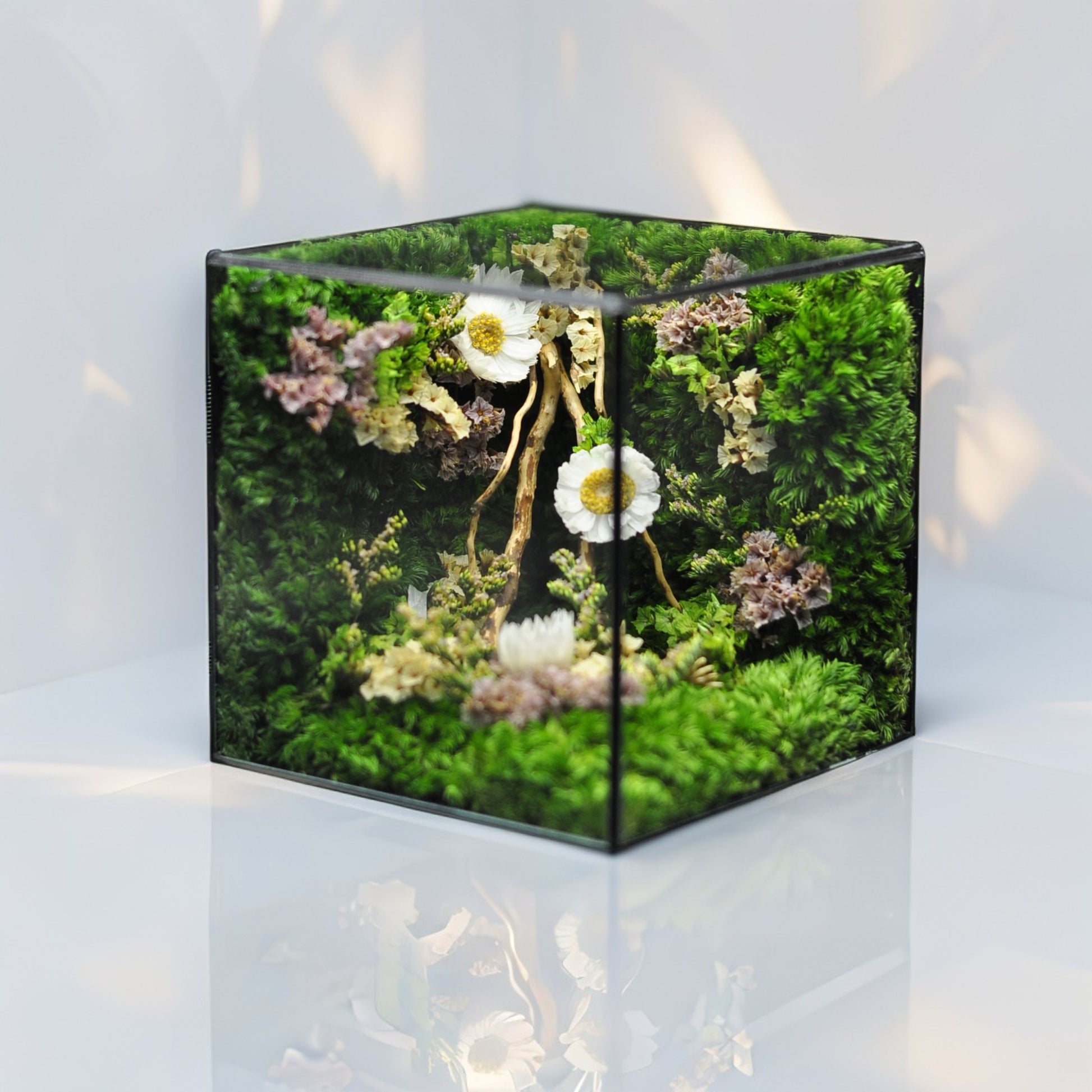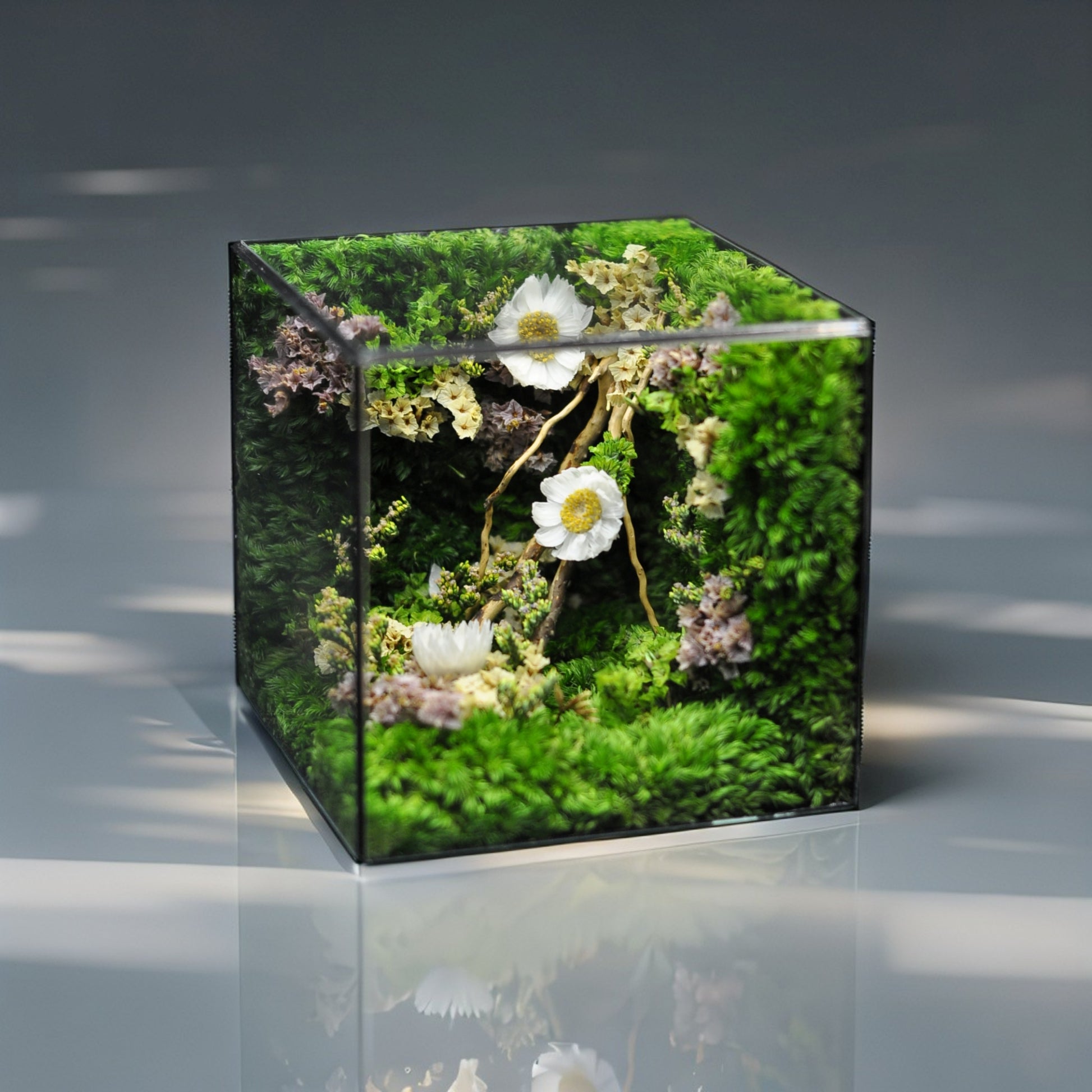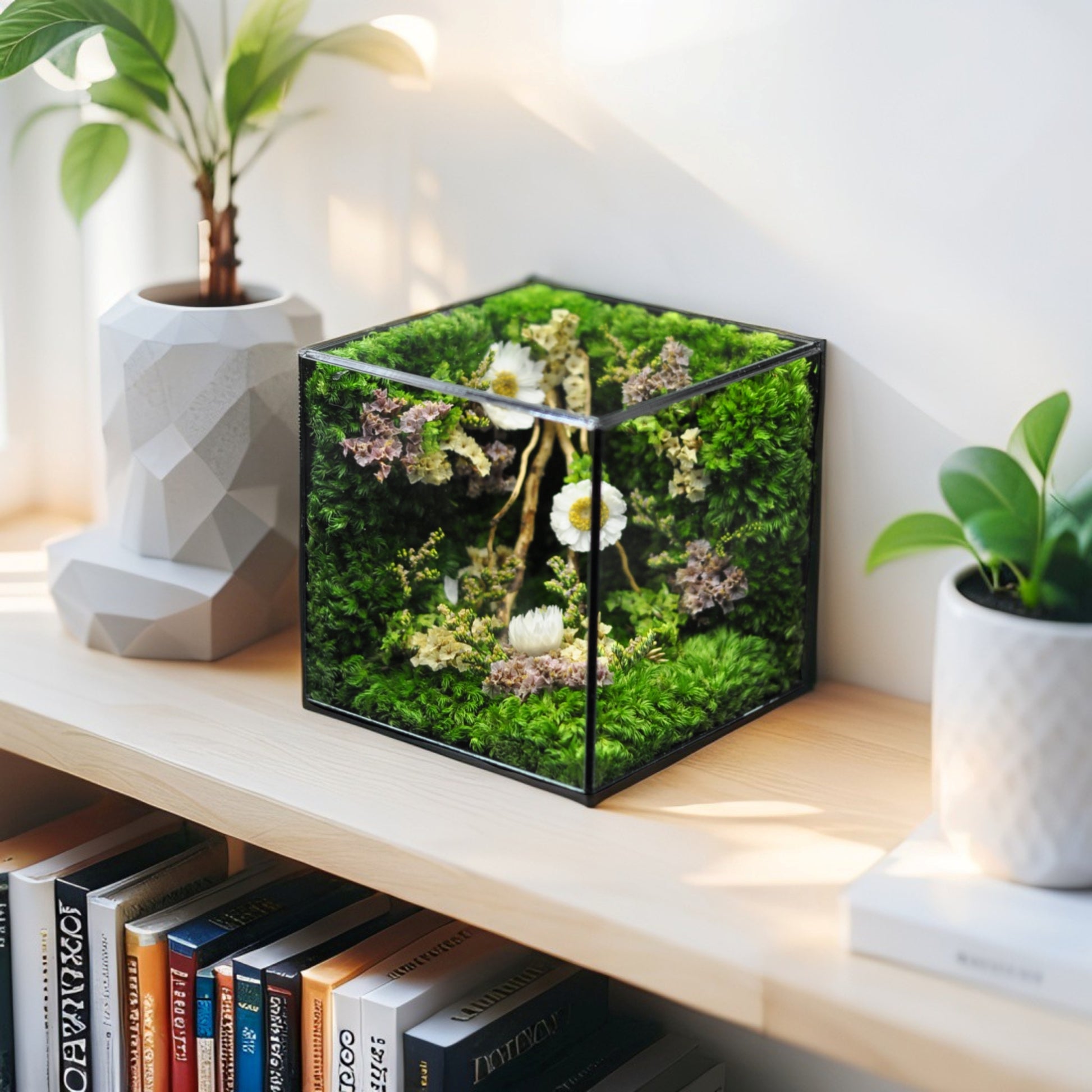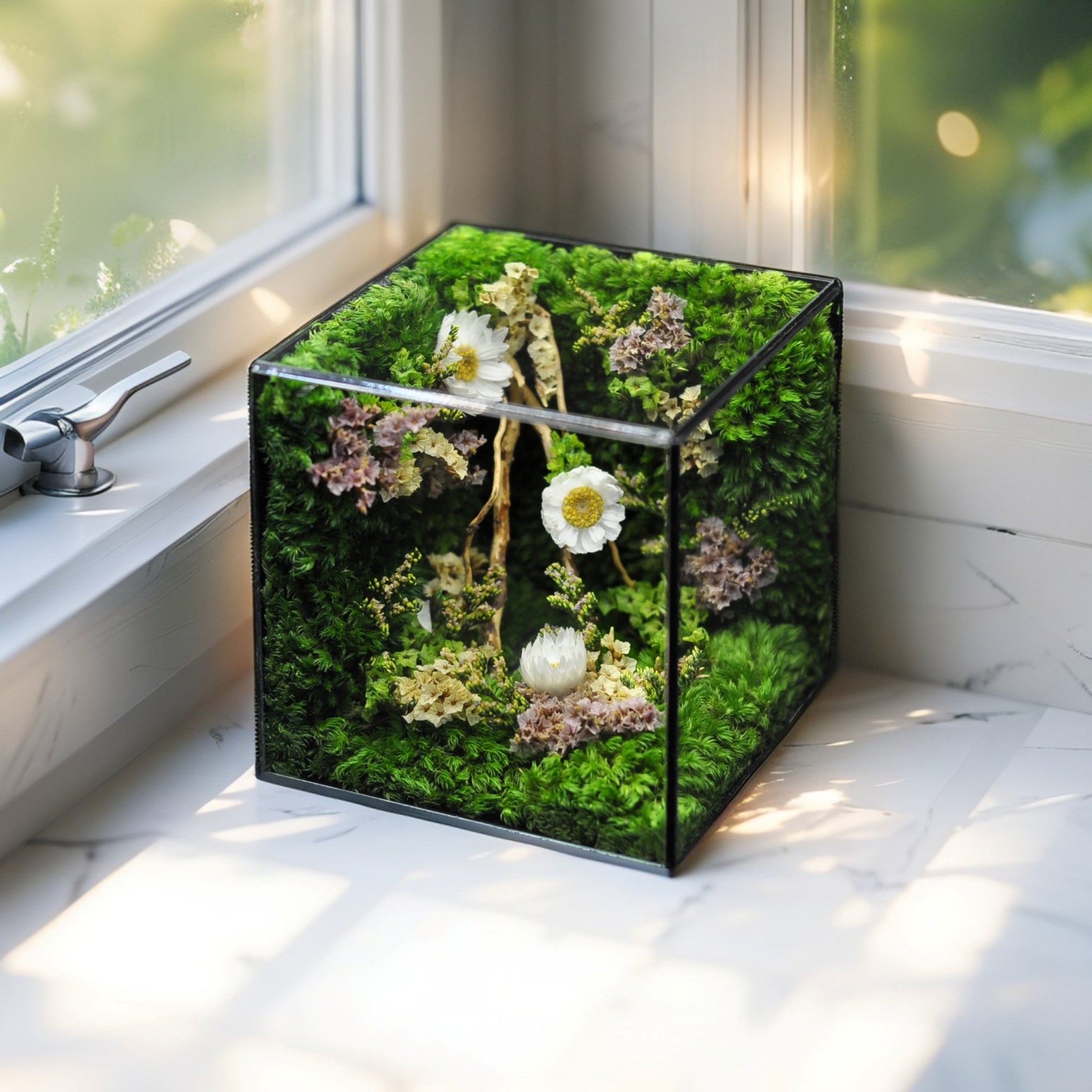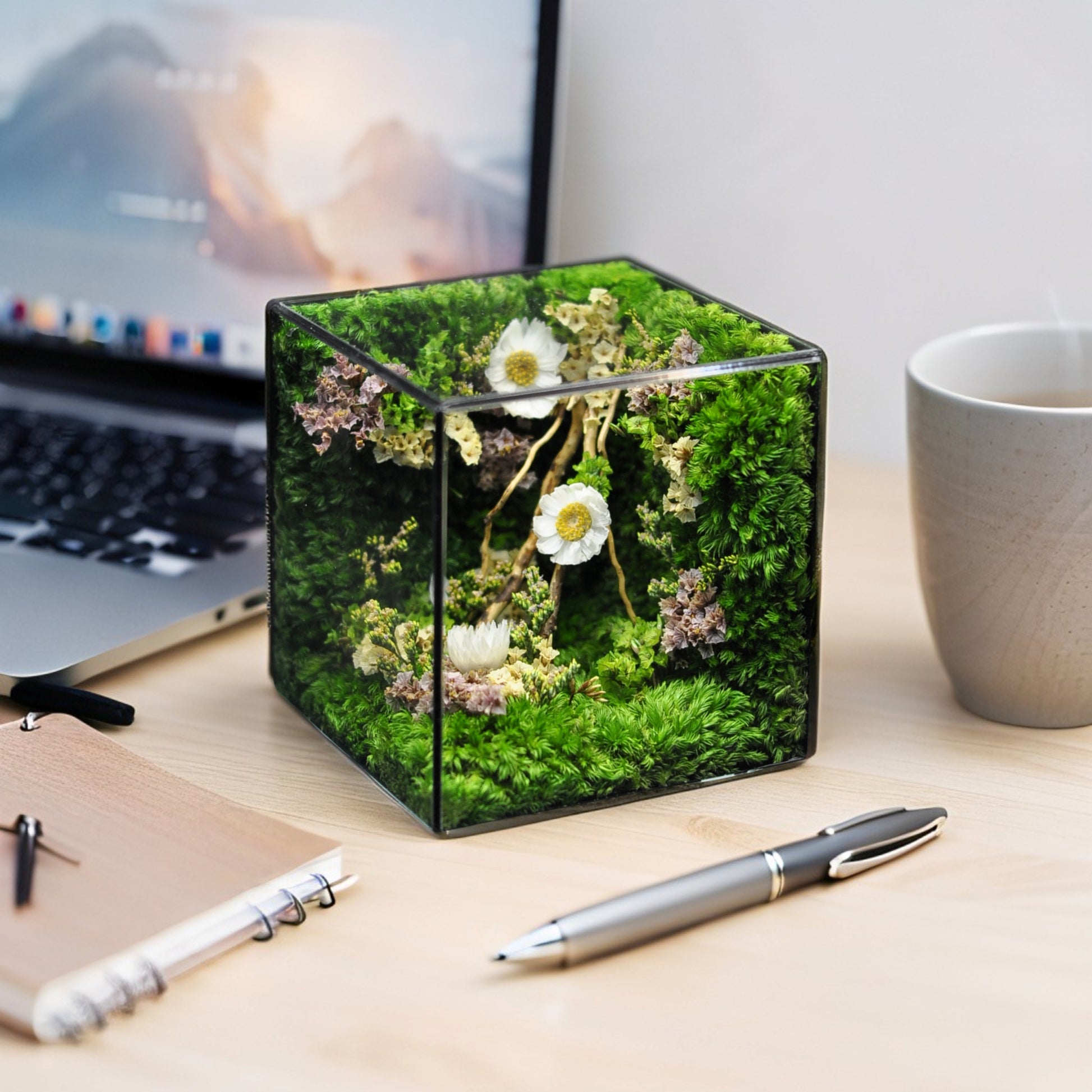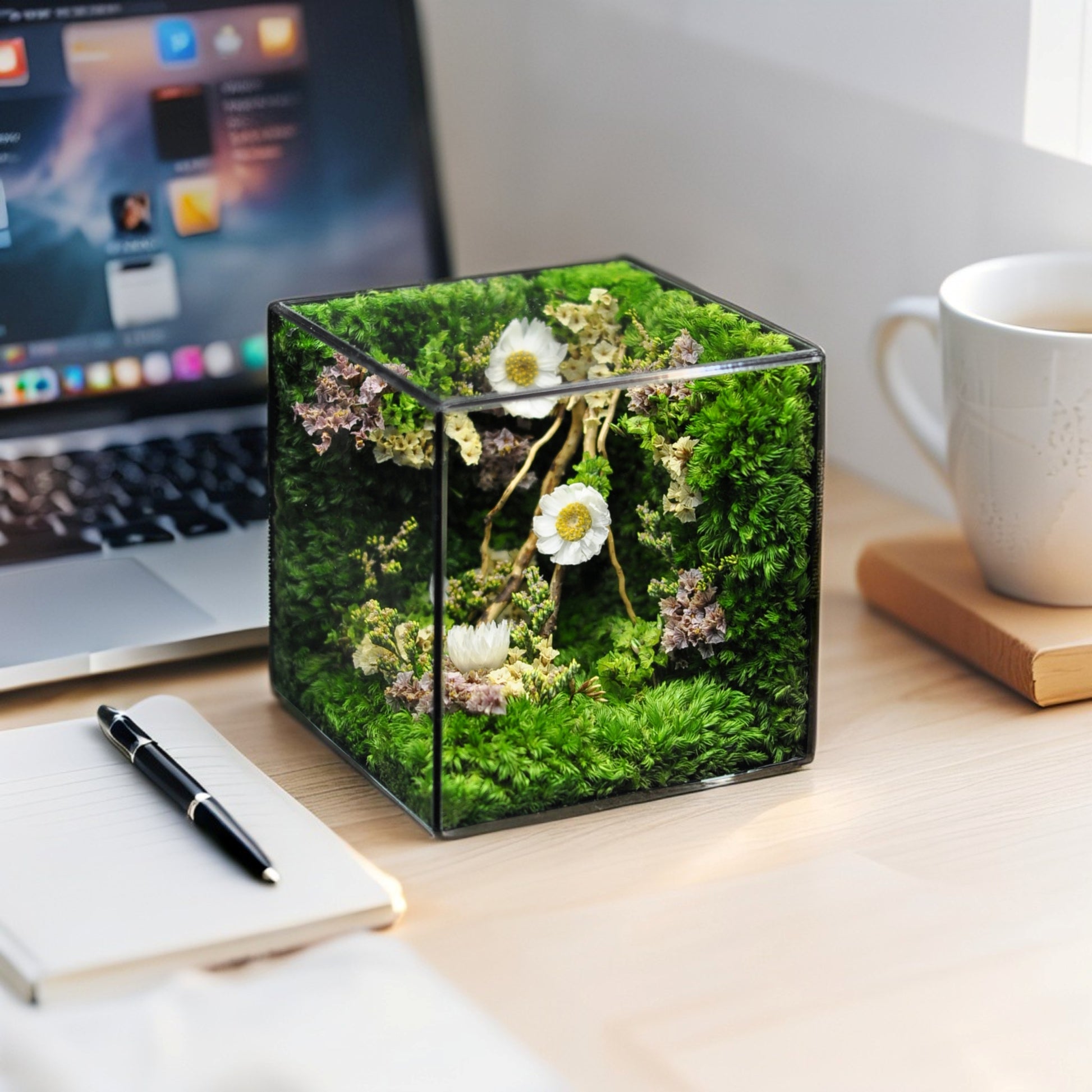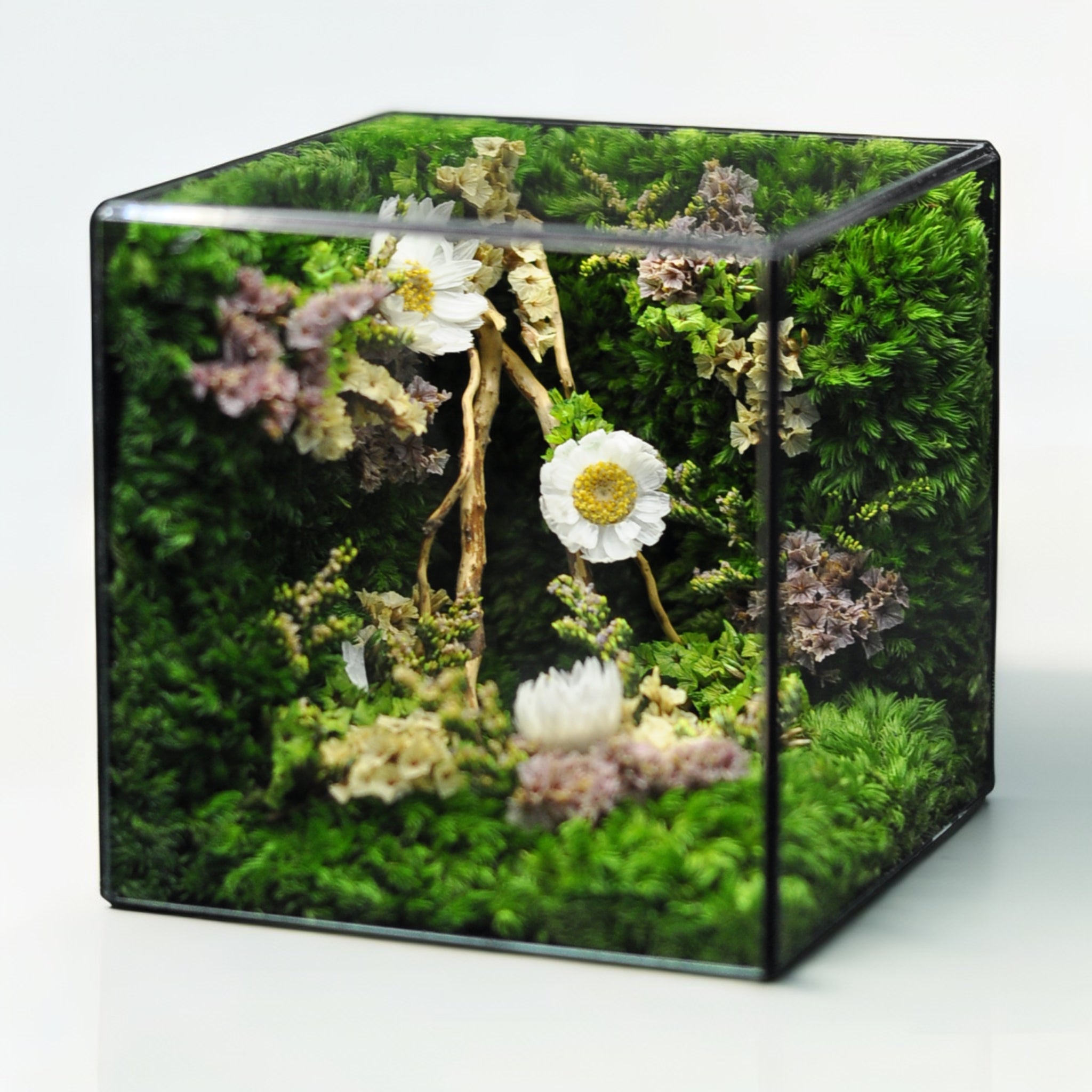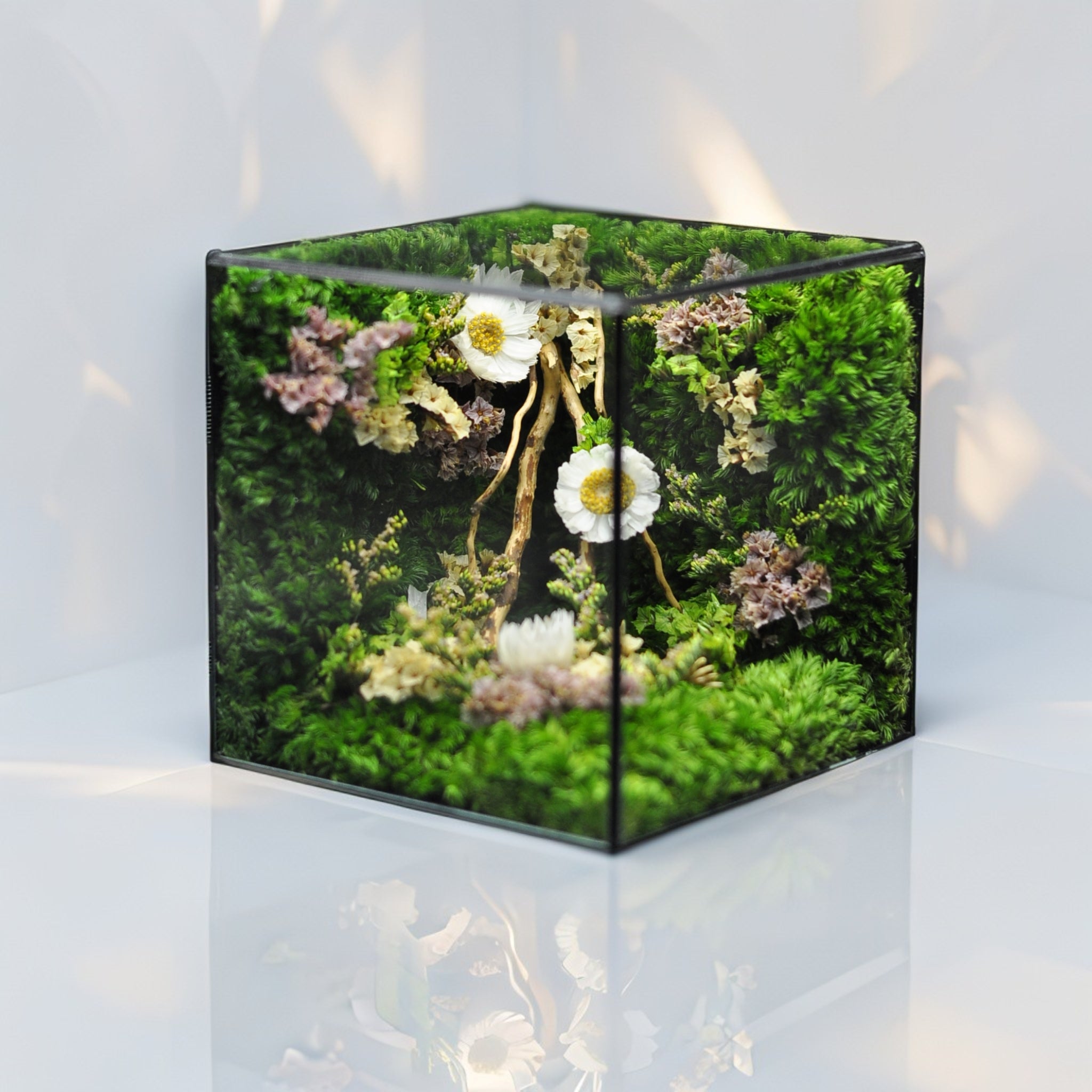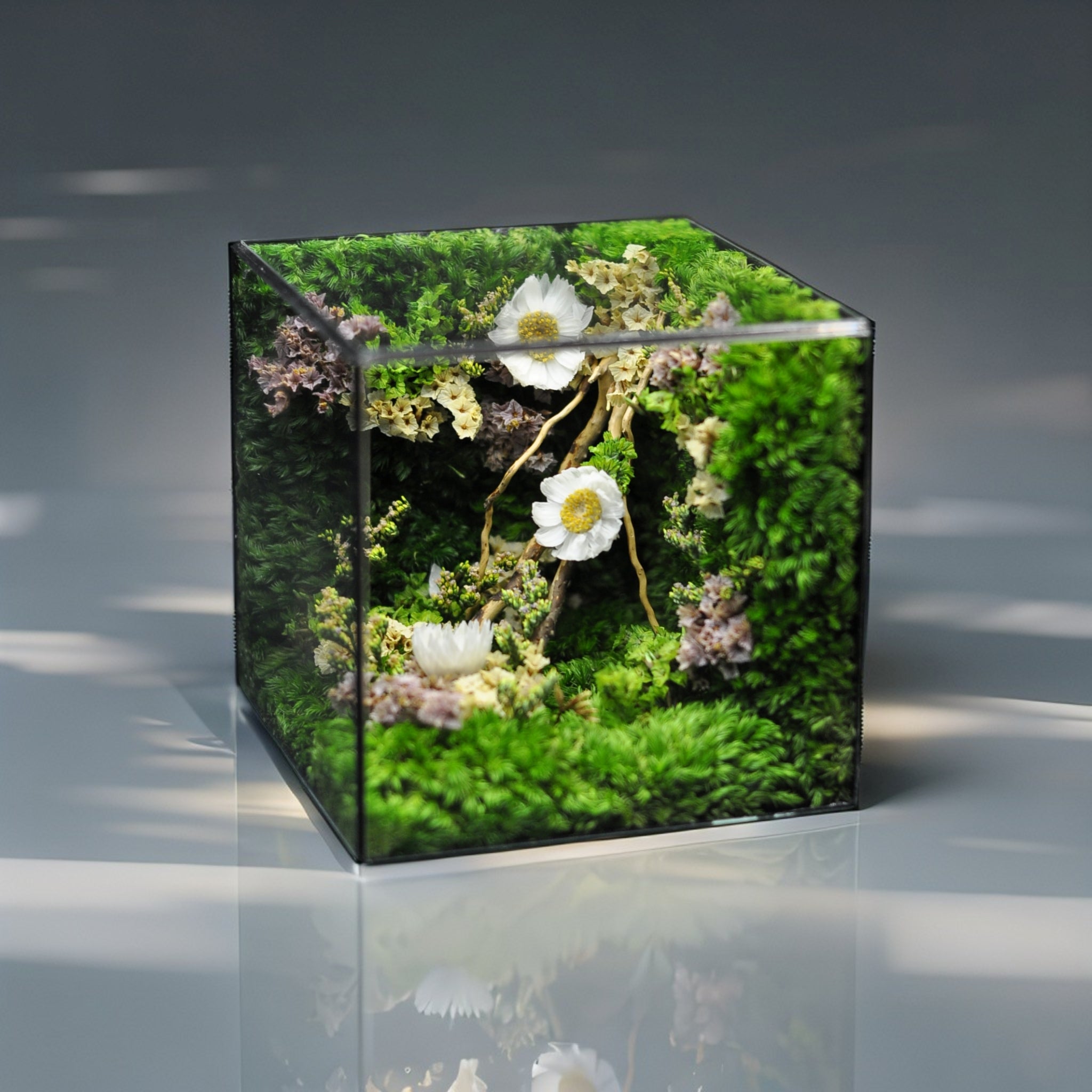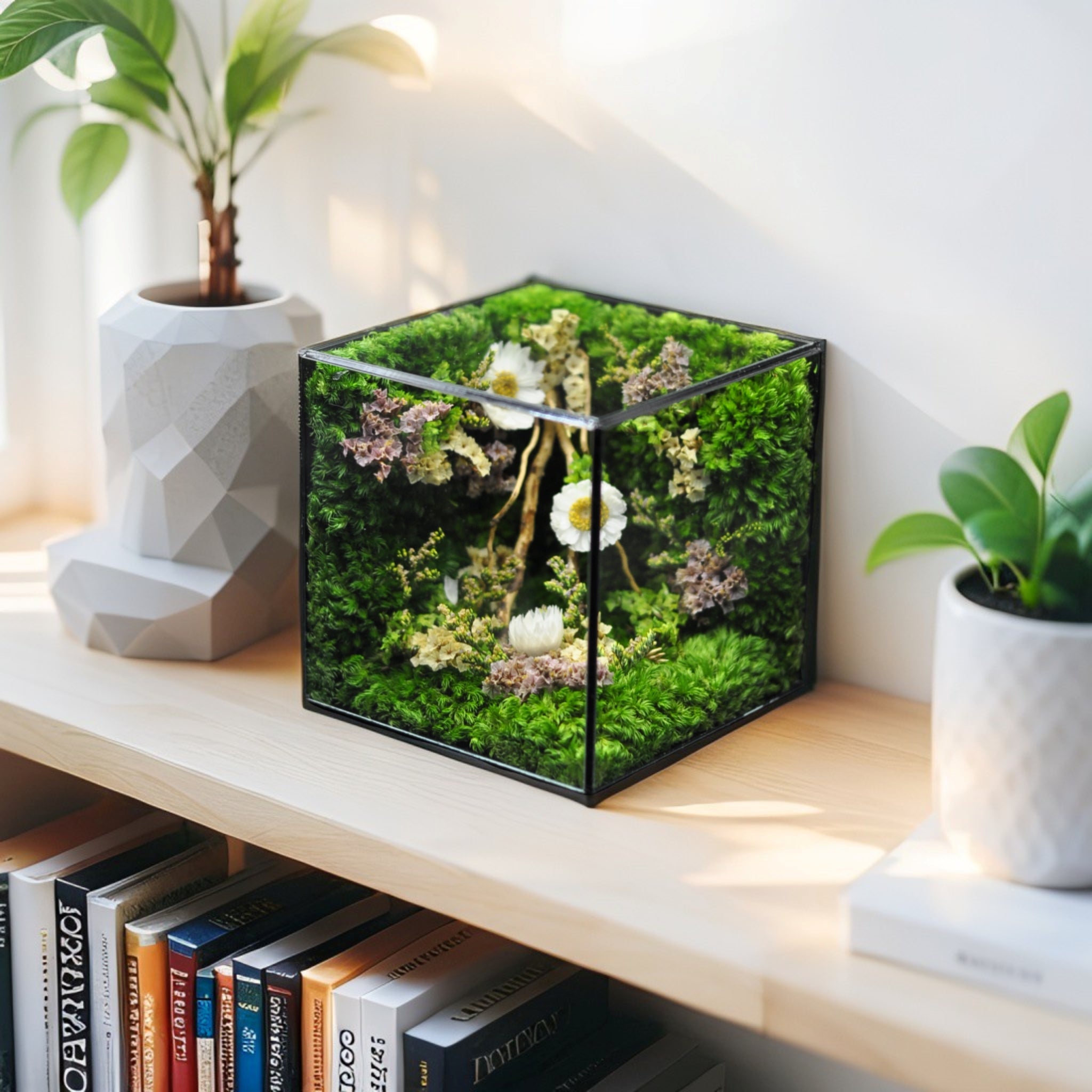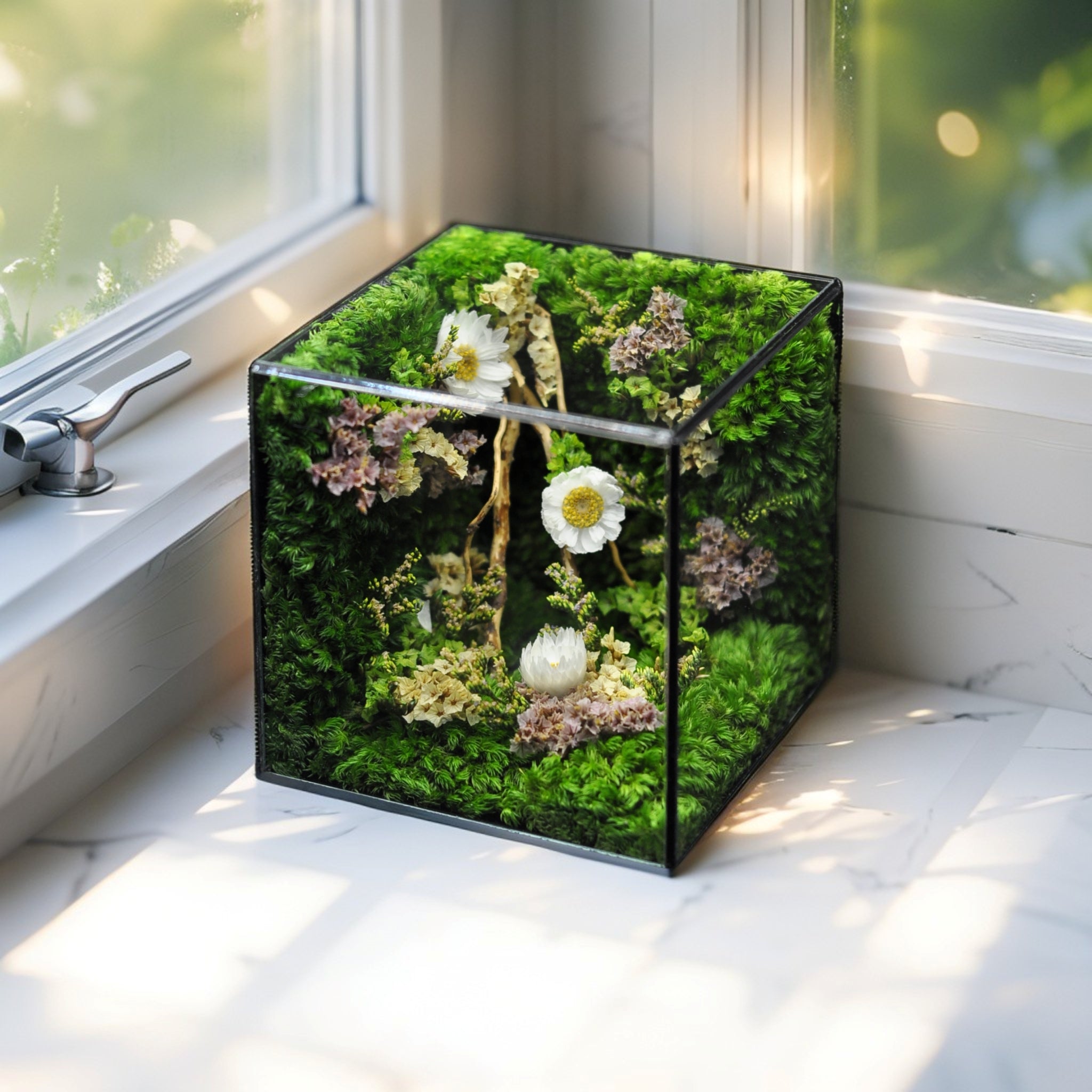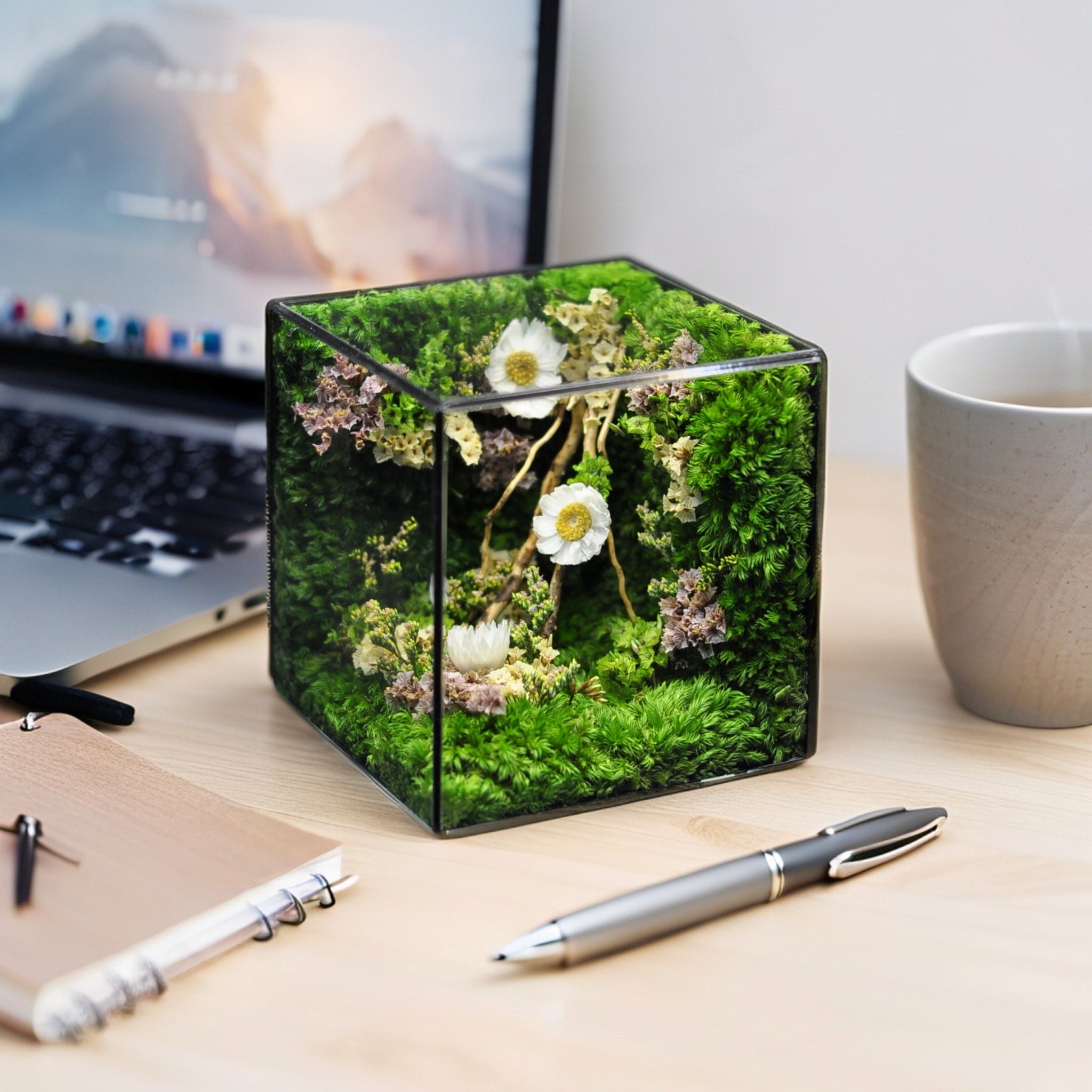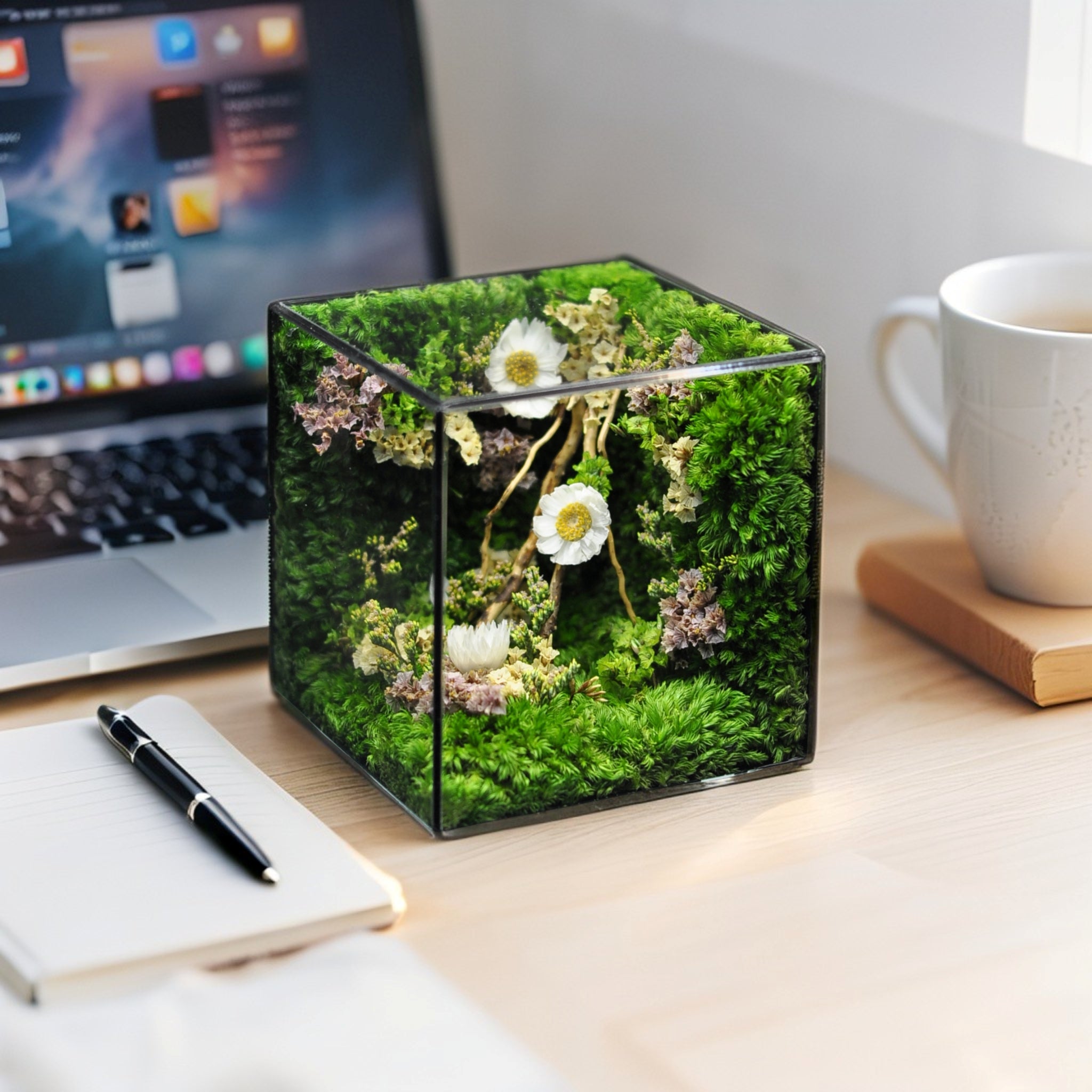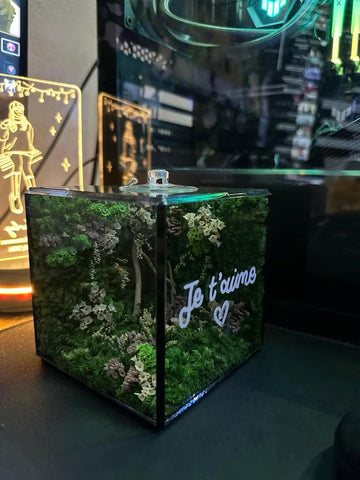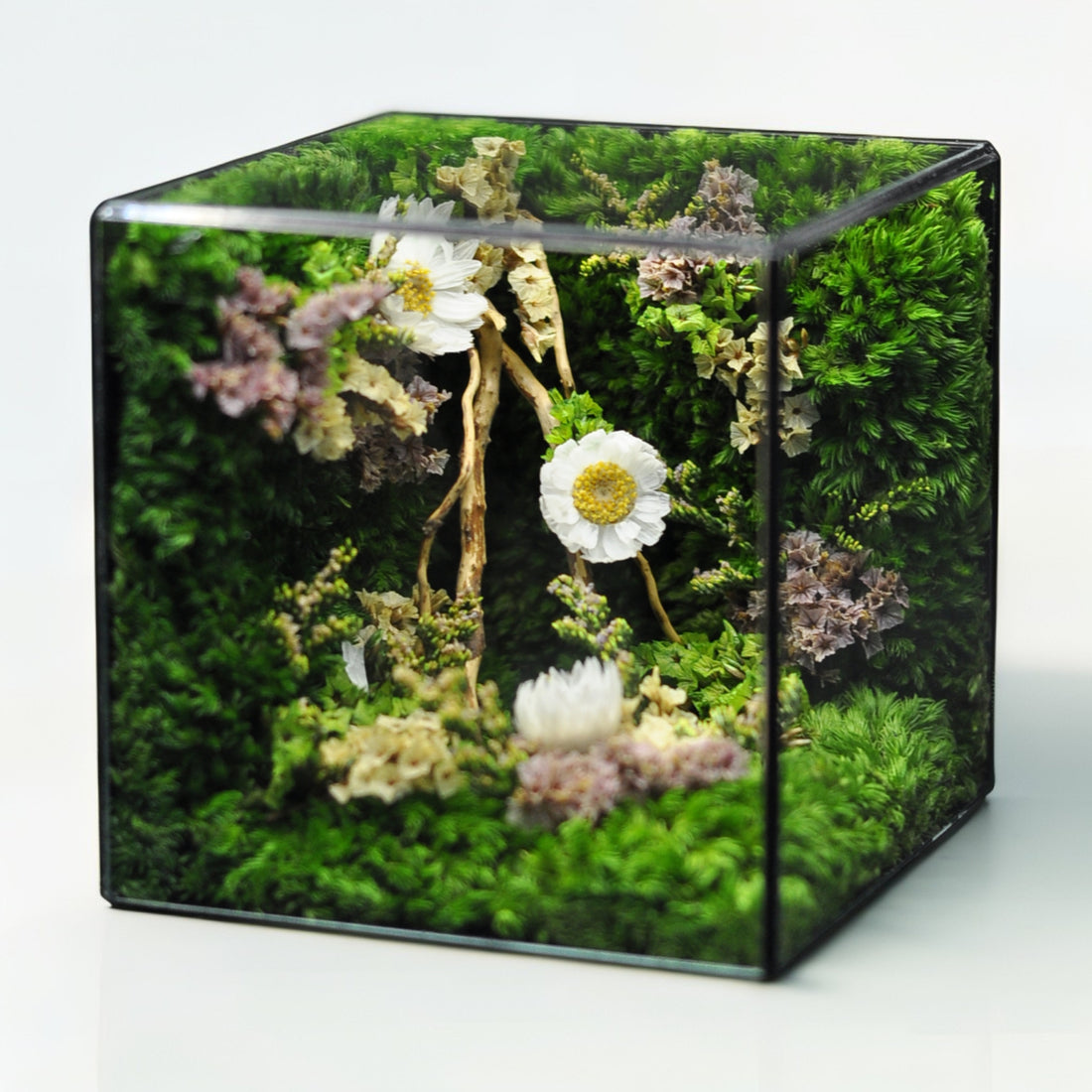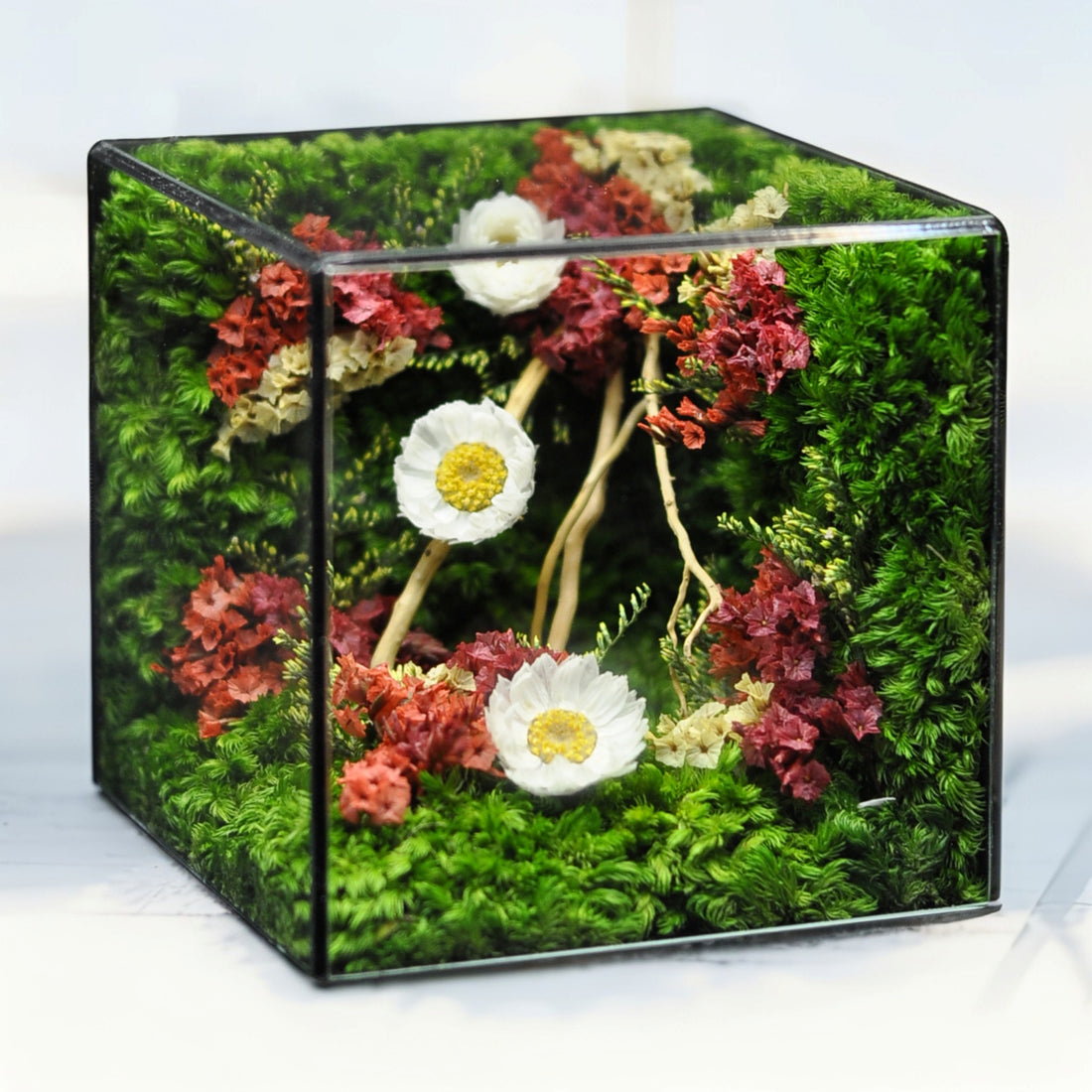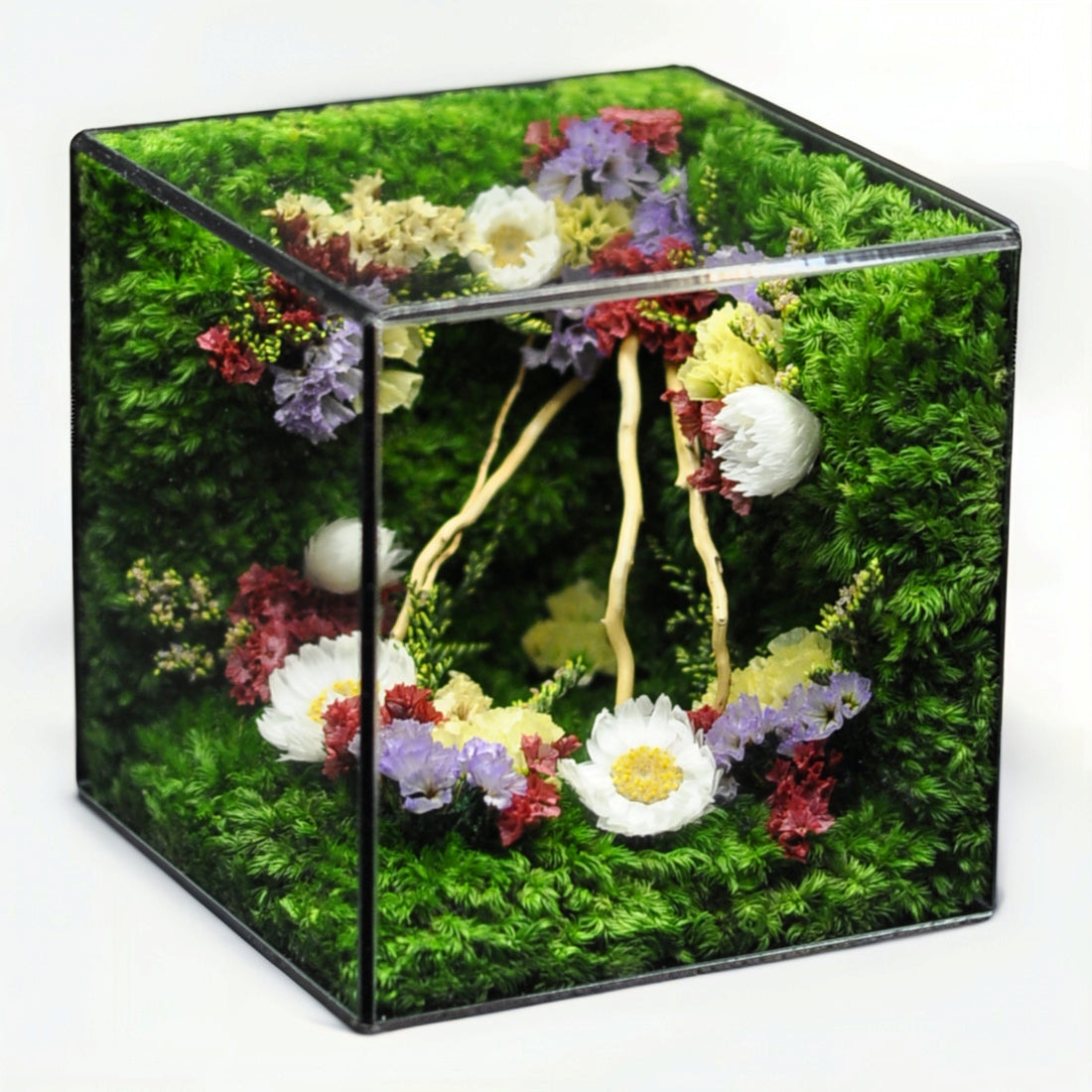Key Takeaways
Preserved terrariums fuse real botanical beauty with hassle-free upkeep, making them an enchanting addition to any space. This guide distills essential insights—from what sets preserved arrangements apart from simple dried florals to top tips for care, styling, and shopping—so you can confidently choose the perfect zero-maintenance green decor.
- Experience living art secured in glass: Preserved terrariums use real plants treated with chemical stabilizers to maintain natural color and pliability, creating an enduring miniature ecosystem without soil or water.
- Differentiate preservation from drying: Unlike air-dried bouquets that become brittle, preserved terrariums undergo glycerin and pigment infusion, locking in moisture and texture for years rather than weeks.
- Enjoy stress-free greenery anywhere: These maintenance-free terrariums thrive without sunlight, watering, or pruning, making them ideal for offices, windowless rooms, and busy households.
- Discover styles to suit every aesthetic: From moss-centric zen gardens and fern-lush forest scenes to themed fairy landscapes and geometric glass globes, preserved terrariums elevate decor in diverse forms.
- Extend lifespan with gentle care: Keep terrariums out of direct sunlight and steam, wipe dust periodically, and avoid exposure to extreme humidity to preserve vibrancy for up to five years.
- Choose reliable sources for true preservation: Seek vendors who detail their stabilization processes, use premium botanical materials, and provide care instructions—artisanal shops and curated online marketplaces are top picks.
- Customize your own verdant keepsake: DIY preserved terrarium kits include treated moss, decorative elements, and clear guides, empowering you to craft a personalized, zero-maintenance indoor garden.
With these takeaways in hand, you’re ready to explore the full spectrum of preserved terrariums—from selecting your perfect style and understanding the science behind preservation to caring for and showcasing your verdant display. Let’s delve into each aspect to ensure you bring home a thriving slice of nature that endures beautifully.
Introduction
Imagine a living work of art on your desk—lush, green, and entirely maintenance-free. A preserved terrarium fuses real plants with chemical stabilizers, locking in vibrant color and pliable texture for years without soil, water, or pruning. Unlike brittle dried florals, these glycerin-infused ecosystems thrive in any light condition, making them perfect for offices, windowless nooks, and busy homes.
In this guide, you’ll learn what makes a preserved terrarium truly everlasting, explore styles from mossy zen gardens to geometric glass globes, and discover simple care tips to keep your greenery vivid for up to five years. We’ll also reveal the best places to buy—or DIY—your own zero-maintenance indoor garden.
Let’s dive into everything you need to choose, style, and cherish the perfect preserved terrarium.
What Is a Preserved Plant Terrarium?
Definition and Key Features of a Preserved Terrarium
A preserved terrarium is a glass-encased display of real plant material—moss, ferns, or foliage—chemically stabilized to maintain its fresh-picked look, soft texture, and vibrant color without ongoing care.
Key Features:
- Lifelike Appearance: Retains natural contours and springy feel.
- Vibrant Pigments: Typically enhanced with non-toxic, water-based dyes per manufacturer safety data.
- Zero Maintenance: No watering, fertilizing, pruning, or soil required.
- Long Lifespan: Remains visually fresh for up to 3–5 years under typical indoor conditions.
Are Preserved Terrariums Real Plants?
Preserved terrariums begin with genuine plant material harvested at peak freshness. Through glycerin infusion, these specimens no longer photosynthesize but maintain their cellular structure and suppleness. Unlike artificial replicas, preserved greenery feels soft to the touch and holds true-to-life color.
Preserved vs. Dried vs. Live Terrariums
- Preserved Terrariums:
- Stabilized with a glycerin solution and pigments (commonly around 5–10% glycerin by volume).
- Soft, flexible texture; vibrant hues lasting up to 3–5 years in ideal, low-light conditions.
- Stabilized cells maintain their structure through hygroscopic action.
- Dried Terrariums:
- Air- or oven-dried plant materials.
- Brittle textures; colors fade on average within 6–12 months.
- Dehydration causes cell collapse and stiffening.
- Live Terrariums:
- Soil-based with living succulents, air plants, or moss.
- Require watering, fertilizing, adequate lighting, and pruning.
- Dynamic growth and seasonal changes.
According to the Botanical Preservation Institute, glycerin’s hygroscopic properties mimic natural moisture, and artisan studios often add a mild biocide to prevent mold over time.
Benefits of a Maintenance-Free, Everlasting Terrarium
Ever wish your office desk could feel like a tranquil forest—with zero upkeep? A preserved terrarium offers just that, combining the serenity of nature with care-free botanical décor.
Zero-Maintenance Greenery for Busy Spaces
- Perfect for home offices, reception areas, or shelves where regular watering is impractical.
- Eliminates pests and over-watering risks common to live terrariums.
- Provides “instant greenery” for gift shoppers and office decorators.
How Long Does a Preserved Moss Terrarium Last?
On average, preserved moss terrariums retain vibrant color and soft texture for up to three years. In ideal indoor conditions—stable temperature, low light, and moderate humidity—premium stabilization methods can extend freshness to five years or more. By comparison, cut flowers last about one week and dried arrangements typically fade within six to twelve months.
Versatile Indoor Garden & Botanical Decor
- Complements any décor style: modern minimalist, boho chic, or rustic farmhouse.
- Thrives in low-light spots—no need for grow lights.
- Doubles as a thoughtful home décor gift for weddings, housewarmings, or corporate events.
Types and Styles of Preserved Terrariums
Preserved Moss Terrariums: Zen Gardens & Forest Scenes
Cushion moss, reindeer moss, and sheet moss create a soft, tranquil tableau reminiscent of a forest floor. Many designs include sand pathways or miniature bridges and range from 4 to 8 inches in diameter, costing $50–$100.
Did you know moss can absorb up to 20 times its weight in moisture? It naturally regulates room humidity and adds a soothing green accent.
Fern-Lush and Leafy Preserved Terrariums
Featuring leather-leaf fern, maidenhair, and eucalyptus, these verdant scenes evoke a tropical retreat. Ideal for coffee tables or entryway consoles, they measure 6 to 10 inches across and start around $60.
“Within days of installing a fern globe in my lobby, guest compliments soared,” reports interior designer Alisha Ray.
Themed Fairy Landscapes & Miniature Worlds
Fairy doors, tiny animal figurines, and miniature mushrooms transform a terrarium into an enchanting miniature world. These playful creations cost $40–$80 and are popular gifts for kids and hobbyists.
Geometric Glass Containers & Globes
Hexagons, pentagons, and hanging orbs offer a modern showcase for preserved greenery. Sizes vary from 5 to 12 inches; prices range $30–$150. Many come as DIY kits with pre-cut glass, silicone joints, and decorative accents—perfect for a weekend project.
How Are Preserved Terrariums Made? (Preservation Process)
What Is Preserved Moss Made Of? (Glycerin & Pigments Explained)
Preserved moss is crafted by infusing plant cells with a glycerin solution—commonly around 5–10% glycerin by volume—that replaces cellular water to keep tissues soft through hygroscopic action. Non-toxic, water-based dyes restore or enhance natural hues. Some artisan studios add a mild biocide to prevent mold growth, ensuring the terrarium stays pristine.
Source: Botanical Preservation Institute guidelines
From Fresh Harvest to Glass Display
- Harvest: Plants are cut at peak vitality.
- Cleaning: Specimens are washed to remove debris and pests.
- Soaking: Materials soak in the glycerin-pigment bath for 1–2 weeks—watch fresh fronds spring back to a supple, natural state.
- Rinsing & Drying: Excess solution drains off.
- Assembly: Stabilized elements are artfully arranged in glass containers.
Quality of Stabilizers vs. Dried Flowers
Stabilizers preserve cell wall integrity and moisture—moss remains cushy, leaves stay flexible. Dried flowers lose moisture only, resulting in a brittle feel and dull color. Preserved arrangements last 3–5 years; dried flora fade within 6–12 months.
Other preservation methods like silica gel drying or freeze-drying maintain shape but often yield a stiff, papery texture. That’s why glycerin infusion remains the preferred technique for long-lasting terrariums.
Care Instructions for Your Preserved Terrarium
Placement Tips: Avoid Direct Sunlight, Steam & High Humidity
- Sunlight: UV rays accelerate pigment fade—opt for bright, indirect light or shaded spots.
- Steam & Humidity: Keep away from bathrooms and kitchens where high moisture can encourage mold.
- Do preserved terrariums need sunlight? No; ambient indoor light is sufficient.
Cleaning and Dusting Zero-Maintenance Plants
- Use a soft paintbrush, microfiber cloth, or canned air to gently remove dust.
- Never mist with water or apply cleaning sprays; moisture degrades stabilizers.
- For tiny debris, place a coffee filter over the substrate before dusting; debris collects on the filter for easy removal.
Maximizing Lifespan: Gentle Handling for Up to Five Years
- Minimize movement to avoid dislodging delicate elements.
- Rotate periodically for even light exposure.
- Real-Life Tip: Office Manager Maria moved her terrarium away from a heat vent after noticing faster color fade; the cooler shelf preserved its vibrancy.
Troubleshooting Common Issues
- Faded Color: Relocate to a less sun-exposed area.
- Dust Accumulation: Schedule monthly dusting with a fine brush.
- Loose Pieces: Tuck elements back into place using long tweezers.
- Accidental Spills: Blot gently with a dry cloth and allow to air-dry fully.
Where to Buy or DIY Your Preserved Terrarium
Best Places to Buy Preserved Terrariums Online
Looking for the best place to buy preserved terrarium online? Check out:
- Etsy: Handcrafted, customizable themes with transparent maker profiles.
- Amazon: Wide selection, customer reviews, and fast shipping.
- Specialty Retailers: The Sill, Terrain, Bloomscape—known for quality sourcing and clear stabilization details.
- Local Florists: Many now offer preserved terrarium services for in-store pickup or delivery.
What to Look for in a Vendor: Stabilization Process, Materials & Price
- Process Transparency: Vendors should disclose glycerin-to-water ratios and any biocides used.
- Material Quality: Look for thick, clear glass and sustainably sourced moss and foliage.
- Price Range: Expect to pay $40–$150 for small to medium displays.
- Packaging: Eco-friendly, robust packaging to prevent breakage during shipping.
Unique Preserved Terrarium Gifts & Ready-Made Décor
- Personalized Nameplates: Laser-etched bases perfect for weddings or corporate events.
- Seasonal Collections: Autumn leaves, winter evergreens, or spring blossoms.
- Corporate Gifting: Logo-branded terrariums that leave a lasting impression.
DIY Preserved Moss Terrarium Tutorial & Kits
- Select a Kit: Choose one labeled “preserved moss terrarium kit” with moss, substrate, stones, and clear instructions.
- Layer Your Base: Place pebbles, activated charcoal, and sheet moss in your glass container.
- Arrange & Seal: Tuck moss pieces firmly; close the lid or globe opening securely.
- Optional Accents: Add miniature props or preserved floral accents for flair.
For a step-by-step DIY preserved moss terrarium tutorial, explore top-rated video guides or browse kits on Etsy and Amazon.
Conclusion
Preserved plant terrariums blend authentic botanical textures and vibrant, long-lasting color with the convenience of zero maintenance. Through glycerin infusion and non-toxic dyes, these glass-encased displays deliver lifelike moss, ferns, and foliage that remain supple and vivid for up to five years—far surpassing the fleeting beauty of cut flowers or dried arrangements. Their styles—from moss-based zen gardens and tropical leaf globes to whimsical fairy scenes and modern geometric vessels—make them perfect for offices, gifts, or home accents in low-light spots.
By choosing reputable vendors with transparent stabilization methods or crafting your own DIY kit—and following simple care tips like avoiding direct sun and gentle dusting—you’ll ensure enduring freshness. Why wait? Elevate your space with a preserved terrarium today and enjoy the calming essence of nature without the upkeep.
Frequently Asked Questions (FAQ)
Q: How long do preserved terrariums last?
A: Preserved moss terrariums typically retain vibrant color and soft texture for up to three years. In ideal indoor conditions—stable temperature, low light, and moderate humidity—premium stabilization methods can extend their freshness to five years or more.
Q: Do preserved terrariums need sunlight?
A: No. Preserved terrariums do not require direct sunlight or grow lights. Ambient indoor light is sufficient, and direct UV exposure can accelerate pigment fading.
Q: Are preserved terrariums real plants?
A: Yes. They begin with genuine plant material harvested at peak freshness and are infused with glycerin to stabilize cellular structure and suppleness. Although they no longer photosynthesize, they maintain a lifelike appearance, soft texture, and true-to-life color.
Q: Can you make your own preserved terrarium?
A: Yes. DIY kits include moss, substrate, stones, and clear instructions. Typically, you layer pebbles, activated charcoal, and sheet moss in a glass container, arrange the preserved elements, seal the opening, and add optional miniature accents.
Q: What is the difference between a preserved terrarium and a regular terrarium?
A: Preserved terrariums use chemically stabilized plant material (glycerin infusion and pigments) to maintain softness and color without soil, water, or upkeep, lasting 3–5 years. Regular (live) terrariums contain living plants in soil, requiring watering, fertilizing, lighting, and pruning, and they exhibit growth and seasonal changes.
Q: Are preserved moss terrariums expensive?
A: Preserved moss terrariums generally cost between $50 and $100, depending on design and size. More elaborate or larger preserved terrariums can range from $40 up to $150.
Q: How is moss preserved in a terrarium?
A: Moss is infused in a glycerin solution—around 5–10% glycerin by volume—which replaces cellular water and keeps tissues soft through hygroscopic action. Non-toxic, water-based dyes restore or enhance natural hues, and some studios add a mild biocide to prevent mold growth.
Q: Where can I buy preserved terrariums online?
A: Popular online sources include Etsy for handcrafted customizable themes, Amazon for wide selection and fast shipping, specialty retailers like The Sill, Terrain, and Bloomscape, as well as many local florists offering preserved terrarium services.

